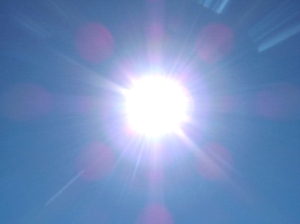Water Safety
July 9, 2013End of Summer Self-Care: Sleep & Nutrition
August 20, 2013Yes, here is yet another post about sunscreen despite this fall-like weather we’re having here in Michigan! Millions of Americans rely on sunscreen for protection from the sun, yet the most deadly form of skin cancer – melanoma – rate is rising. The number of patients in the US with diagnosed melanoma has tripled over the past 35 years. Sunscreen plays an important role in preventing sunburn, but only if used correctly.
SPF? Waterproof?
What is SPF? SPF stands for “sun protection factor.” Which do you think is better – a High SPF (over 50), a middle of the road SPF (between 30 and 50), or a low SPF (under 30)? The answer might surprise you.
The first thing you should know is that sunscreen is NOT protection against all types of sun damage. The sun’s ultraviolet (UVA and UVB) radiation generates free radicals that damage DNA and skin cells, accelerate skin aging, and may cause skin cancer. SPF ratings are aimed at blocking UVB rays (the main cause of sunburns and pre-cancerous cells) and have very little to do with a sunscreen’s ability to block UVA rays. However, UVA rays which penetrate deeper into skin tissue, cause more unseen and long-term damage than UVB rays.
Low-SPF products do not provide enough protection from either UVA or UVB rays. High-SPF products lend a false sense of security and people tend to not apply enough sunscreen and they stay in the sun too long. Sunscreens with an SPF rating between 30-50 and broad spectrum protection provide the best protection when applied before going outside and then reapplied often throughout the day.
Does your sunscreen say “waterproof” or “water resistant”? It may not be as proof or resistant as it claims. Always reapply after spending time in the water!
Potentially Toxic Common Sunscreen Additives
Sunscreens with higher SPF ratings (over SPF 50) have higher concentrations of sun-filtering chemicals. While these chemicals may help block harmful rays, they cause damage of their own.
1) A form of vitamin A (Retinyl palmitate) is added to nearly one-quarter of all sunscreens sold in the US. Retinyl palmitate may speed the development of skin tumors when applied to skin in sunlight. It’s probably best to avoid any sunscreen product with “Retinyl palmitate” in the ingredients.
2) Oxybenzone is used in nearly half of the beach and sport sunscreens. It soaks through skin, where it can trigger allergic skin reactions and may disrupt hormones.
Chemical vs. Mineral
There are two types of sunscreen: 1) “chemical” sunscreens are not very stable, penetrate the skin, and may disrupt the body’s hormone system, and 2) “mineral” sunscreens, made with zinc and titanium, often “micronized” or containing nano-particles a twentieth the width of a human hair. These help reduce or eliminate the chalky white tint that these minerals used to leave on the skin. The “mineral” sunscreens may be less damaging overall to your body’s hormones and skin cells.
The key to purchasing the best sunscreen product is to read the label and the ingredients list. It’s time consuming but well worth the time invested.
Sunshine serves a critical function in the human body— the production of vitamin D. Vitamin D is critical for healthy bones and the immune system and reduces the risk of breast, colon, kidney and ovarian cancers. About 25% of Americans have borderline low levels of vitamin D, and 8 percent have a serious deficiency. People with darker skin, older people, and people who have limited sun exposure (those of us who live in the northern part of the US) are at the greatest risk. Check with RAHS about a vitamin D test or to see if you need to take vitamin D supplements.
Reduce Your Risk
1) Sunscreen is not a tool to prolong your time in the sun.
2) Wear a hat, sunglasses, and a shirt with sleeves.
3) Avoid getting burned!
4) Avoid tanning beds!
5) Keep kids out of the hot sun.
6) Take a vitamin D supplement, especially if you live in the northern part of the US.
7) Check your skin – if you notice tender or growing spots, contact your doctor.
Related articles
- Sunscreen: To Use Or Not To Use? (charlotte.cbslocal.com)
- Sun Protection for Outdoor Workers (prweb.com)
- 10 Tips for Finding Safer, Non-Toxic Sunscreens (non-toxickids.net)




